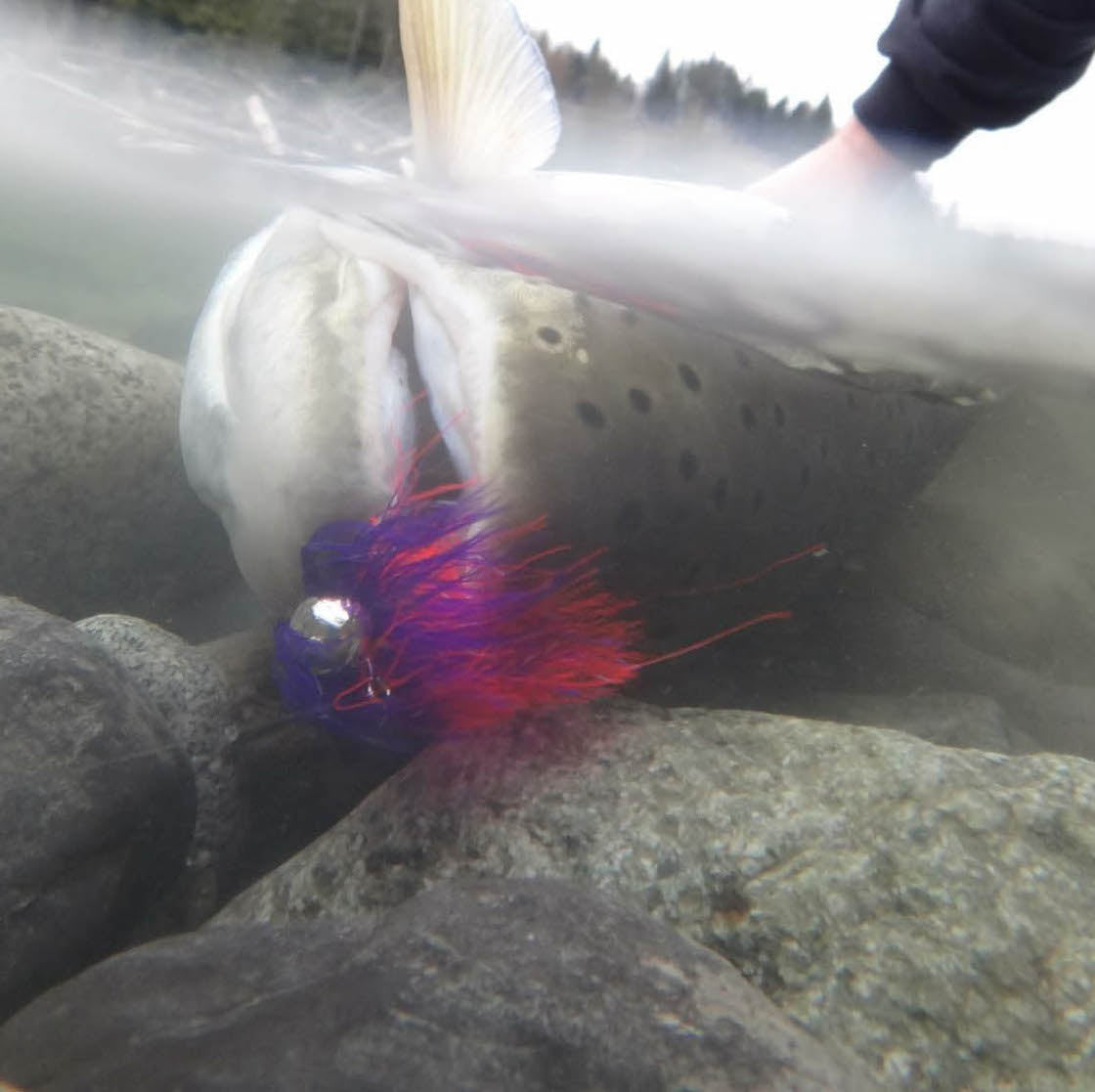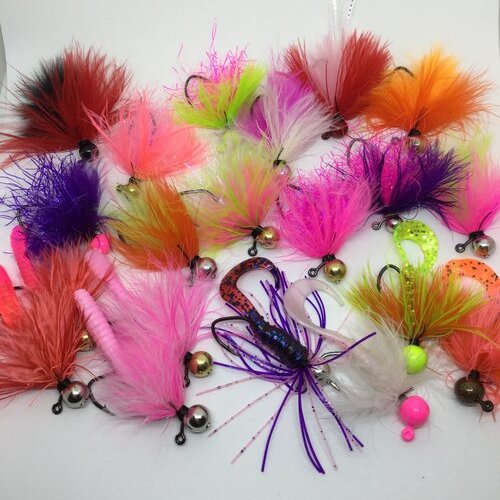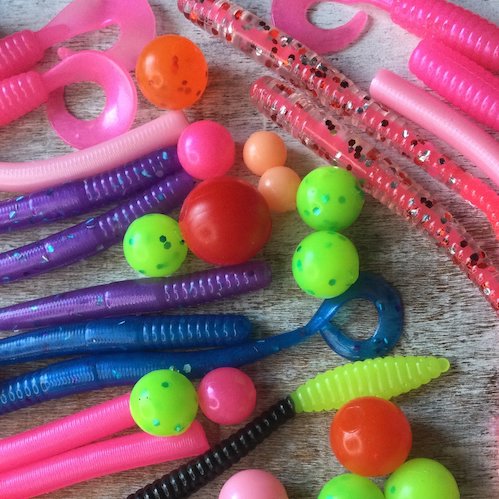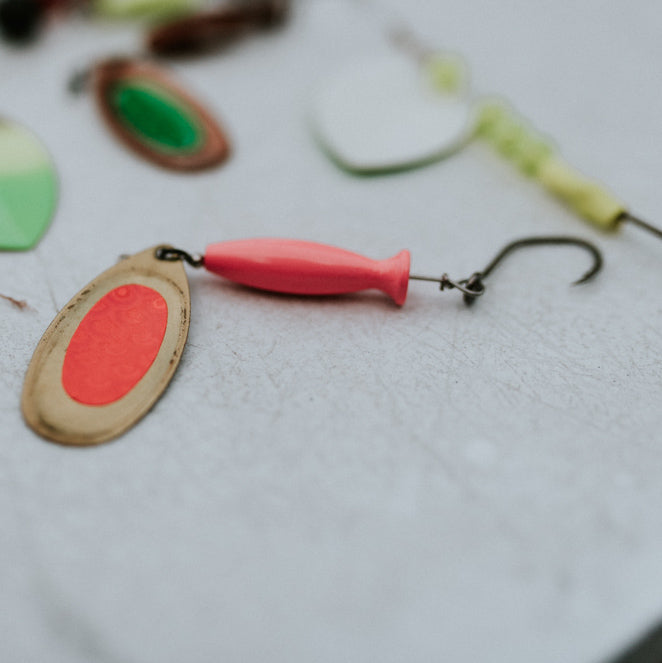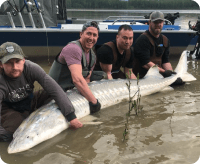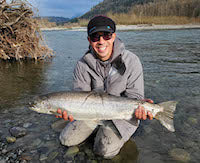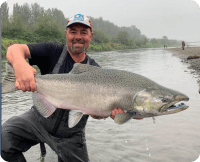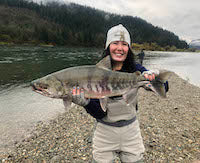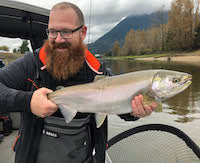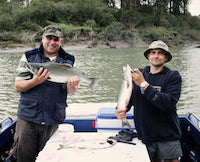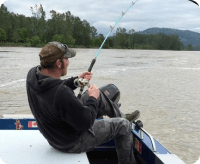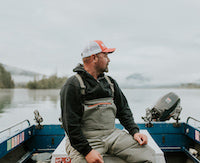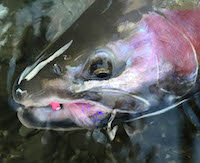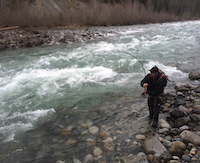
Quite often I am asked, “What is the best and most effective way to catch Chinook Salmon in rivers?”
There are so many methods of catching Chinooks in rivers that I could write an entire book on the subject. I will try to keep it fairly simple and talk about the methods I personally use for success in my local rivers.
Bait Fishing: Roe
Fishing bait is very effective for Chinook Salmon. Of all the Salmon, Chinook in my experience, are by far the most tempted by juicy, cured chunks of roe. When curing my eggs for Chinook fishing, I use a scent heavy cure and then add additional scents to that standard scent of the factory made cure. Pro Cure Bait Scents has a tremendous line up of factory cures and scent additives which allow you to create a unique and bold combination to excite the senses. My two current favourites are the Pro Cure ‘double red hot stuff’ and the newer ‘fuze cure’. In addition to the base cure, I like to add either ‘blood tuna’ powder or Pro Cure’s ‘powdered krill’.
My favourite strategy when fishing roe for Chinook Salmon, is to use fairly large egg clusters under a float. One major downfall to fishing any bait for Chinooks, is that these Salmon will often sit in heavy water. The power of the heavy water tends to tear the roe away from your hook. For this reason, I have leaned away from bait fishing Chinooks over the years, and focused more on fishing artificials.
Some other good bait options for Chinook Salmon worth mentioning, are prawns, shrimp, ghost shrimp, and squid. Without going into great detail, I typically fish my prawns and shrimp by curing in a roe cure to slightly toughen the bait and give it some colour. I don’t add scent additives when curing prawns and shrimp, as the natural scent of these baits is all you need.
Ghost shrimp can be fished fresh and live. Again, the fragility of bait is a factor here, and trout tend to persistently snatch them from your presentation.
I mentioned squid as a good bait option, but it is not the entire squid I fish. I mainly use the legs of the squid to tip jigs, which I will elaborate on later.
Bead Fishing: Soft Plastic Beads
Over the last decade, fishing beads for Salmon and Steelhead has become quite popular. There are many good reasons for its relatively new popularity. It is highly effective, cleaner than fishing bait, and allows for more variation of size and colour, which makes it very versatile.
When Salmon and Steelhead are young and living in a river, single eggs are one of the most common and natural foods available to them. I tend to believe that this is why all fish in rivers are so keen to grab a single egg when presented.
While many believe that a natural colour and size is of utmost importance, I have found that a larger size and bright colour will often outperform the natural bead, hands down! My personal preference is soft plastic beads. I have experienced far more success with the soft plastic than the hard plastic counterpart. For Chinook fishing, I mainly use 16mm and 14mm size. I like to pack a wide variety of colours with me. Some good colours to have along are oranges, reds, peach, and chartreuse. As a bead maker, I have experimented with glitter and pearl finishes. Some days a pearl or colour shift bead will be the Chinook favourite. Remember to try a variety of colours if you know Chinook are present. Many days you will find the fish keying in on a particular colour that is far from natural. Another colour variation I have found good success with, is the half and half mix; a single bead in two different colours. These double coloured beads are also known by the term ‘laminated’.

A little trick that my fishing buddies and I use for all Salmon and Steelhead, is to drape a bit of scent soaked wool over your bead. You can achieve this by putting the wool in your bait loop, and have it drape down onto the hook. For wool, I typically use white or peach- or a blend of the two. If you like to run your bead pegged, just tip wool on the leader above the bead with a simple overhand knot.
We came about this while fishing roe for Chinook in fast, heavy water. Frustrated by our roe chunks being torn off the hook by the current, leaving only a white piece of roe skin, we pulled out a bead and slid it onto the hook with the remaining roe skein (aka snot) draping the bead. In the same piece of water where we hadn’t been able to hook Chinook with our roe chunks, we were immediately rewarded with a number of fish on the bead and snot!
This led to using wool to imitate the snot, and has become a great addition to our bead game.
As for the tackle I use with bead fishing, I stick to the same simple float fishing set up I use for bait fishing. Set your float to fish the bead just off the bottom. I like to have the bead bouncing off the bottom only occasionally. No need to be dragging bottom, as this will result in gear loss and retying.
I stick with a 14-18” leader, and seldom go less than 12 pound. I actually favour 15 pound, and even 20 pound in the short, fast pockets which often hold Chinooks.
Shop Soft Bead Multipacks for Chinook Salmon
Colorado Blades
On many occasions I have witnessed Chinook Salmon favour the flashing metal and coloured paint of float fishing Colorado blades, over all other presentations. I always keep a good variety of blades in my pack. Colorado blades are best fished in water with enough speed to keep the blade spinning. Some colours I have found productive are pink, orange, and chartreuse. I use both silver and brass blades with a coloured sticker or airbrushed paint, on the outer side. I fish the Colorado blade in a manner that it spins just off bottom where the fish are holding.
For tackle, I use the very same float set up as in bead and bait fishing. Keep the leader between 14-16” for best results.

Jigs- Float Fishing
While jig fishing using a float set up is normally associated with Steelhead fishing, I find it very effective for all Salmon as well.
I tend to keep my colour choices very simple. Pinks, reds, oranges, and peach are my go-to Chinook colours. Often, I will use jigs with two contrasting colours, and a combination of feather and UV polar chenille. When float fishing jigs for Chinook, a little bait is an important addition. For this, I use small pieces of raw, uncured prawn- or raw, uncured squid legs. Simply slip a very small piece of prawn or a few squid legs onto the hook, at the back of your jig.
Important to note with float fishing jigs, is that dragging your jig on the bottom will result in less hook ups and lost jigs! Be sure to set your depth so that the jig is 6-12” off bottom.
For the set up, I fish jigs in a very similar manner to bait and beads- with the important difference of shortening my depth to keep that jig off bottom.
The float fished jig will often rise to the occasion when other presentations aren’t performing!
I think this is because the jig elicits an attack response from the fish, as opposed to a feeding response.
Twitching Jigs
While this is not currently a technique being widely used for Chinook Salmon fishing in the Fraser Valley, twitching jigs is quite popular throughout the Pacific Northwest and on the Skeena River system.
As Chinook Salmon will often sit in deep and fast water, your choice of twitching jig size is of utmost importance in order to get it to the depth needed. I favour the 1/2 oz jigs for twitching Chinooks, and will even use 3/4 oz jigs if a situation requires it.
Colours for twitching jigs are not nearly as important as the technique. The colours I lean towards are purple, black, blue, orange, and pink. I like jigs with a least two different colours, or even three.
I use a 9’ medium bait cast rod, with a low profile bait caster with a high gear ratio. I use 30 pound braided mainline with a minimum 15 lb leader, uni knotted to my mainline. A spinning set up will also work well. The key to twitching for Chinooks, is to get it down in front of them and use a fairly sharp ‘pop and drop’ technique.
Remember, the fish will bite the jig on the drop, so giving some pause to let the jig drop is key!
Finding Chinook Salmon
The key to finding Chinook, is knowing the type of water that they will hold or rest in, depending on the river conditions.
High Water
When rivers are high, Chinook Salmon will be mainly travelling up river. In these conditions, I target their REST SPOTS or TRAVEL LANES.
Rest Spots: A rest spot will typically be a seam where two channels meet; a side channel or a soft piece of water before a section of very fast and heavy water. As I hike the river, I target and move through those spots very quickly and directly. If fish are present, they will generally hit your offering right away, so you will know if the spot is productive or not within a short time frame.
Travel Lanes: When targeting the travel lanes, I try to identify spots where Chinook will be slowly traveling in their upstream journey, as opposed to the faster surrounding waters where they will be traveling through more quickly and be unlikely to bite your offering. An example of this is a long narrow run where the water is traveling faster than the rest spots, but slower than the rest of the river. It is good to find 3 or 4 travel lane spots, in different sections of the river. Spend at least an hour in each spot. The purpose of fishing this travel lane for a somewhat considerable amount of time, is that Chinook can move into the spot anytime while you are fishing it, and you could get lucky in one of your chosen zones. I will often circle back through these spots two times in a full day of fishing.
Prime Water Levels
When the river is at ideal fishing levels, the Chinook Salmon will often hold in slightly faster parts of a run that are at least 4 feet deep, which provides them with visual cover from predators. I seldom find Chinook holding in slow or shallow water. They seem to prefer water a minimum of 4- 8 feet deep, flowing at a brisk walking speed. In these conditions, fish will hold for a day without moving up river. These prime water levels provide fantastic fishing opportunities for willing biters.
Low Water
In low water, Chinook can be found holding in the deep, fast heads or deep sections of a run. Look for water that is roughly 7-12 feet deep with a fast current. One strategy I employ, is using a light leader like 12 lb fluorocarbon with 12mm-10mm soft plastic beads, rather than my go-to Chinook bead size of 16mm-14mm.

Rods, Reels, and Terminal Tackle
I will keep this short and simple. Chinook are very hard fighting Salmon, so it is important to be prepared with gear that can withstand the fight they will give you!
Your fishing rod should be 10-12 feet in length, and rated medium or medium/heavy.
My suggested reel choices for float fishing Chinook are level wind reels, or bait casters as they are often called. A reel that can hold a minimum of 150 yards of 20lb braided line is required. My favourite of these reels are low profile bait casters, such as the Shimano Curado or Daiwa Lexa.
For center pin reels, almost all brands will work well. Your reel must be able to hold a minimum of 150 yards of 20 lb monofilament line.
In recent years, Chinook Salmon runs have been much improved. These hardest fishing of all Salmon are great fun to catch, and a thrill for anglers new to the sport. In 2022 we will see the first double return, since the Chilliwack River hatchery doubled their smolt releases in 2018 for the Fall Chinook Salmon.
This is a fantastic time to get out and give Chinook Salmon fishing a try! If you are looking for tackle or a day of guided fishing for Chinook Salmon, we can hook you up!
Tight Lines & Bent Rods!
~Rod Toth
P.S. If you have questions regarding techniques, tackle set ups, or fishing options - email me at fishing@bentrods.ca



